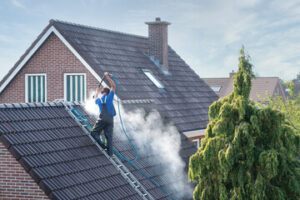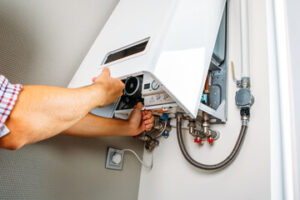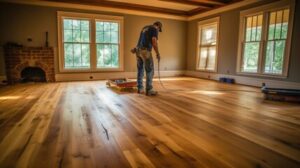Roof Cleaning Sarasota helps protect a home from water damage, which can cost thousands of dollars. It also makes the house more comfortable to live in and increases the property’s value.

Professionals usually spray a solution of bleach (the same kind you use to whiten laundry) and water onto the roof. This kills off algae and moss growth.
Algae, also known as cyanobacteria or slime mold, are primitive plants that thrive in water and on wet surfaces such as roofs. They can be black or green in color and create unsightly stains on the surface of your roof. Algae growth on a tile roof can discolor the tiles, absorb heat unevenly, and promote the growth of other organisms such as moss and pests. It is important to remove algae from your roof as soon as you notice it growing. This will help to prevent the spread of the spores to other parts of your home and property.
The best time to remove algae is during spring or summer when the weather is drier and warmer. Using a professional roof treatment during this time is an ideal way to kill the algae and clean up your roof. It is a much safer and effective way to remove the growth than using a power washer or a scraper, which can damage your roof.
Generally, roof algae grow because of a combination of factors. Overhanging branches, clogged gutters, standing water, porous roofing materials, and poor ventilation can all contribute to the growth of algae on your roof. Once the algae begins to grow, it can be difficult to remove.
The easiest and most common method for removing algae from your roof is to use a bleach solution. The bleach will kill the algae and moss, allowing you to scrub away the stains. Be sure to test the solution on a small section of your roof before applying it to the entire surface. This will ensure that the bleach won’t damage your roof or void your warranty.
You can also use a product called Spray & Forget Roof Cleaner, which is a biodegradable and non-corrosive solution for removing algae, mildew, moss, and lichen from shingle roofs. This product can be purchased online or at most home improvement stores and is an effective alternative to power washing or scraping moss and algae. The cleaner can be applied to the roof with a pump sprayer and will need to sit for about 30 minutes. Then, you can rinse the solution off with a garden hose to remove any remaining traces.
Debris
The roof is one of the most important features of your home, as it protects you and your family from the elements. But, like any other part of your home, the roof needs to be cleaned on a regular basis to prevent build-up from occurring. Debris on the roof can create a lot of problems, including attracting pests and clogging gutters. In addition, debris can also damage the structure of your home. Keeping your roof clean will help to protect your investment, and it will also increase the overall value of your home.
To remove any debris from the roof, start by sweeping it thoroughly. Then, spray a solution of water and detergent on any areas where you see black stains or growths. The solution will dissolve the dirt and grime, making it easier to clean the rest of your roof. You can use a commercial roof cleaner or you can make your own cleaning solution using mild soap and water. Just be sure not to get too close to the surface, as you could damage your roof or hurt any plants that are in close proximity.
If you have a lot of debris on your roof, you may want to consider hiring a professional to do the job for you. However, if you’re going to attempt to do the job yourself, it is best to start with a broom and sweep as much debris as possible. Then, move to a leaf blower or other power tool that will help you to quickly and easily remove any remaining debris.
You should try to do this work on a day with clear skies and minimal wind speed. This will reduce the risk of any fallen debris hitting anyone below. Also, low wind speeds will mitigate the possibility of blown debris landing on workers and creating trip or slip hazards. If you have a skylight or chimney on your roof, be careful to avoid aiming the blower at those structures, as they could be damaged. Lastly, you should take special care to cover any items of value in your house or garage before starting the roof cleaning process.
Dirt
Dirt, sand, dust and other outdoor materials can make their way onto a roof and cause it to look grimy. Roof cleaning removes this dirt and helps to prevent it from building up again.
A dirty looking roof can reduce a home’s curb appeal and lower its value. Regular roof cleaning can keep a roof looking its best and can prolong its lifespan.
Asphalt shingles have come a long way in the last few decades and are less prone to moss and algae growth and those unattractive black streaks, but dirt and environmental factors can still wear away at the life expectancy of your roof.
Cleaning your roof can be done manually with a broom or leaf blower to remove loose debris such as pine needles, branches and leaves that can trap moisture close to the surface of the roof. This constant moisture can also help moss grow, and if left untreated moss can damage the shingles and lead to water leaks into your home.
If you want to do your own roof cleaning, it’s important that you use proper safety equipment. This includes a harness and fall arrest equipment to ensure that you don’t slip and hurt yourself. Additionally, you should also wear protective clothing including long pants, a long-sleeve shirt and gloves, and a mask to protect yourself from the chemicals in many cleaning products.
When cleaning a roof, it’s generally a good idea to start from the top and work your way down, rather than trying to cover as much area as possible at one time. This will give you a chance to spot any problem areas that may need additional attention or repairs before they get worse.
You can use a variety of cleaners to clean a roof, but bleach is usually the best option. The chlorine in the bleach can kill off any moss or algae growth and also helps to remove any dirt or grime that has built up on the surface of the roof. Be sure to choose a low-VOC bleach that won’t harm surrounding plants and trees.
Mold
Mold is something homeowners don’t want anywhere in their homes, especially on the roof. It’s a sign of more serious issues like leaky roofs and poor ventilation, and it’s not good for anyone’s health. If you find spots of mold growing on the roof, it’s important to remove them as quickly as possible to prevent further problems.
Mold can be difficult to spot, especially since it typically grows in dark areas that are largely hidden from view. However, the best way to check for mold is by doing a thorough roof inspection. This is also an ideal time to look for other signs of problems, such as discoloration on the attic floor or in drywall around windows.
If you do suspect you have a mold problem on the roof, it’s best to contact a professional roof cleaner to make sure the job is done correctly and safely. Professionals will know how to use a special product that kills mold and keeps it from returning, as well as other products that won’t damage the roof or leave behind spores that can grow into more mold.
The most common way to remove mold from the roof is to spray it with a bleach solution. However, it’s important to be careful during this step and wear rubber gloves and a respirator. If you don’t, the mold spores will spread into your home and cause further damage. It’s also a good idea to rinse the roof after spraying it with clean water. It’s important to avoid using a power washer because this could damage the shingles and leave them vulnerable to future damage.
In addition to using a bleach solution, many professional roof cleaners also use a product called D7. This is a powerful algae and mold killer that can be applied as either a foam or a spray, making it easier to reach hard-to-reach places. It also clings to the surface of the roof, so it’s less likely to wash away before killing any mold spores that are present. It’s best to apply the product during cool or cloudy weather so it doesn’t evaporate before it has a chance to work.

